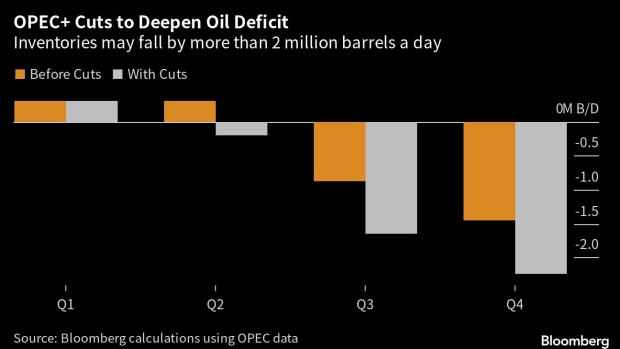Global oil markets will see a significant supply shortage this year as production cuts by major exporters begin to recover.
According to OPEC data cited by Bloomberg, the global shortfall is about 2 million barrels per day in the fourth quarter, beating an expected surplus of 300,000 barrels per day in the second quarter.
This comes after OPEC and its partner Russia announced sharp production cuts. OPEC cut its planned output by a million barrels a day on April 2, citing a hedge against price shocks after a brief drop in oil prices caused by the banking crisis in March.
Shortly after the OPEC news, Russia also announced that it would continue to cut its 500,000 barrels per day until the end of the year. The actual decline in oil production may not be as steep as the announced production quota cuts, as some allies are already producing below target levels.
However, the potential for oil supply constraints looms as demand continues to grow, adding pressure to crude prices, which have risen 20% in the past month.
OPEC predicts that oil consumption will increase by 2.3 million barrels per day this year and reach a new record of 101.89 million barrels per day.
Oil futures rose to $87 a barrel in London after the cuts were announced. This fueled fears about inflation and global economic growth while supporting incomes for the 23 members of the OPEC coalition. Some forecasters believe that a tougher outlook could herald a return to $100 oil.
A report on Thursday from OPEC’s Vienna-based research division supports cuts that are expected to shrink this quarter’s projected supply surplus.

Oil inventories are above the five-year average, and current production in the 13 OPEC member countries is about 300,000 barrels more than needed, or 28.8 million barrels per day, from April to June.
However, in the second half of the year, the world market tightens considerably. OPEC already expected the supply shortfall to widen this summer, and the recently announced cuts will make the shortfall even more obvious. Although OPEC described the cuts as a “cautionary measure aimed at supporting market stability”, the group still predicts a significant increase in global oil demand this year.
In practice, OPEC production cuts are expected to be smaller than advertised, as some members are already pumping below their target levels. But even if only the group of Gulf nations implements the deal, OPEC production is expected to fall to around 28 million bpd – about 1.6 million bpd less than the organization estimates it will need in the third quarter and at least 2 million more less than needed in the quarter.
A key member of the wider OPEC coalition, Russia, which has been cutting production in particular in response to sanctions imposed over the war in Ukraine, could significantly moderate the shortfall. OPEC estimates expect Russian supplies to fall by an average of 750,000 barrels a day this year and suffer a sharp collapse this quarter.
Russian exports have proved stubbornly resilient despite promises to counter international mistrust over the attack, although a slowdown in the latest shipping data suggests sanctions may be biting.
The OPEC alliance will review production policy for the second half of the year at a meeting in early June.




Leave a Reply